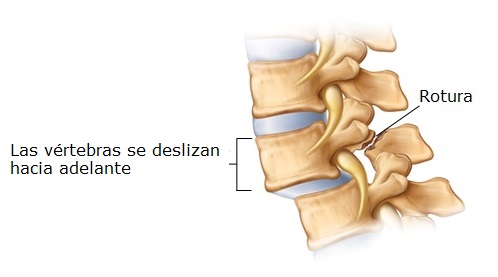The spondylolisthesis, it's an intimidating word at first glance, but all you have to do is divide it into 4 sections: it is – Mon. – dilo – listis. So it's not that hardíeasy to pronounce.
That is why this conditionón médica is often abbreviated as “listis”. It's not that hard eitheríeasy to understand if you think that the término comes from raígreek aces: espóthat is the significa “vértebra” and listhesis means “slide”.
Spondylolisthesis occurs when a vévertebra slides forward on the vélower vertebra.
Máit's often, this occurs in the lower back (lumbar area), as it is a part of the spine that supports a great deal of weight and absorbs a great deal of directional pressure.
In other words, the lumbar spine has to move a little (rotate in various directions) with body weight.
Sometimes, this combine usócan't put that much énphasis and las vévertebrae that one of them slides forward.

Some activities make meás susceptible to spondylolisthesis. Gymnasts, the football players, and the weight lifters all put pressure onón and significant weight on their lower backs.
Think about the gymnasts and the positions in which they put their body: práthey practically fold in half backwardsás, that something extreme that can be harmful to the vertebral.
Spaghettién twist quickly in the air while doing somersaults and then land on the ground, absorbing the impact throughés of your legs and lower back.
These movements place substantial stress on the spine, and spondylolisthesis can develop as a result of repeated excessive stresses and stress.és.
The Médicos have 5 different grades to measure spondylolisthesis, depending on the distance you see itévertebra has slipped forward.
During your appointment with the méI say you may hear him talk about “a degree of spondylolisthesis”. Something that Iás ahead I canás discover.
Index
signs and exámenus to diagnose spondylolisthesis
It's hardíeasy to know if someone has spondylolisthesis, because I may not have anyún sísymptom or crushing pain – as it happens with the majoríto the people.
Spondylolisthesis is usually discovered when you areán conducting studies for something else and the méI say or shaveólogo, realizes that a vévertebra appears displaced on an x-ray.
X-rays are the best way to diagnose spondylolisthesis. during the x-rayía, probably standing, taken sideways, is when the médico can get a side view, that shows más clearly slipping.
Regarding the radiographyía superior, you can see that one of the vévertebrae has slipped out of the spine. The arrow willñala the spondylolisthesis.
youéI say tambiéCan't order an x-rayíto oblique. Oblique means that the radiographíto be taken in a áangle from the back, a view to help youá al méI say to see the lámina, articular veneers, and interarticular parts.
To know if your spondylolisthesis is unstable and mobile, the médico can ask you to perform flexions and extensions seen from the side. Éthese tooén are called views of flexión lateral.
an x-rayíto the flexión is taken with the patient leaning forward; an x-rayíto extensionón is taken when bending backwardsás.
For further confirmationón of spondylolisthesis, the patient may need to undergo a CT scaníto computerized.
And at védisplaced vertebraá pressing nerves, the médico can order a myelogram. In this test, a special dye is required, which is injected into the áarea around the nerves that are in a sac for the tincture to enter that sac (before that happens, anesthetize yourselfá the área.).
then it will be possibleá perform the x-rayítake her to the tomographíto computerized. The result provideá an image goneóslightly detailed spine, especially from the bones, that will help youádo you have meéI say to identify any abnormality.
Part of your visit to the méI say includeá exáis meant fíphysical and neurológicos. in the exam fíphysical, youéI say takeá take into account the posture, range of motion (thaté so good and whaté how far certain joints can move), and the conditionón física, observing any movement that causes pain.
The méI say palpateá your spine, taking into account your curvature, to paragraphsón, and the sensationóNo muscle spasms. Spondylolisthesis can cause you to walk abnormally, so the méI say tendrá to watch you while you walk.
During the neuronal examógico, the spine specialist will putá test your reflexes, muscle strength, and other nerve changes, así like the propagationóno pain (that is to say, if he back pain travels to other parts of your body).
The exesáis meant fíphysical and neurológicos will giveádo you have meéI say a good idea of cófor védisplaced vertebraá affecting your body and your life.
Slip degrees

Using the radiographsíside ace, the méI say qualifyá your spondylolisthesis. Using a scale starting with the “Grade I” and advance to “Grado V” that describe whaté so far forward has your life slippedértebra.
Grade I is a slip of less than 25 %.
Grade II is a slip of the 25 % al 50 %.
Grade III is a slip of the 50 % al 75 %.
Grade IV is a slip of the 75 % al 100 %.
Grado V is for a vévertebra that existsído from vélower vertebra. (That is an extreme case of spondylolisthesis., which has its own name: Spondyloptosis)
1 thought on “Spondylolisthesis”
Comments are closed.